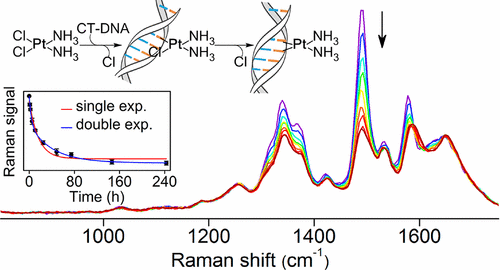当前位置:
X-MOL 学术
›
J. Phys. Chem. B
›
论文详情
Our official English website, www.x-mol.net, welcomes your
feedback! (Note: you will need to create a separate account there.)
An Ultraviolet Resonance Raman Spectroscopic Study of Cisplatin and Transplatin Interactions with Genomic DNA
The Journal of Physical Chemistry B ( IF 2.8 ) Pub Date : 2017-09-19 00:00:00 , DOI: 10.1021/acs.jpcb.7b08156 Jiafeng Geng 1 , Mena Aioub 1 , Mostafa A. El-Sayed 1 , Bridgette A. Barry 1
The Journal of Physical Chemistry B ( IF 2.8 ) Pub Date : 2017-09-19 00:00:00 , DOI: 10.1021/acs.jpcb.7b08156 Jiafeng Geng 1 , Mena Aioub 1 , Mostafa A. El-Sayed 1 , Bridgette A. Barry 1
Affiliation

|
Ultraviolet resonance Raman (UVRR) spectroscopy is a label-free method to define biomacromolecular interactions with anticancer compounds. Using UVRR, we describe the binding interactions of two Pt(II) compounds, cisplatin (cis-diamminedichloroplatinum(II)) and its isomer, transplatin, with nucleotides and genomic DNA. Cisplatin binds to DNA and other cellular components and triggers apoptosis, whereas transplatin is clinically ineffective. Here, a 244 nm UVRR study shows that purine UVRR bands are altered in frequency and intensity when mononucleotides are treated with cisplatin. This result is consistent with previous suggestions that purine N7 provides the cisplatin-binding site. The addition of cisplatin to DNA also causes changes in the UVRR spectrum, consistent with binding of platinum to purine N7 and disruption of hydrogen-bonding interactions between base pairs. Equally important is that transplatin treatment of DNA generates similar UVRR spectral changes, when compared to cisplatin-treated samples. Kinetic analysis, performed by monitoring decreases of the 1492 cm–1 band, reveals biphasic kinetics and is consistent with a two-step binding mechanism for both platinum compounds. For cisplatin–DNA, the rate constants (6.8 × 10–5 and 6.5 × 10–6 s–1) are assigned to the formation of monofunctional adducts and to bifunctional, intrastrand cross-linking, respectively. In transplatin–DNA, there is a 3.4-fold decrease in the rate constant of the slow phase, compared with the cisplatin samples. This change is attributed to generation of interstrand, rather than intrastrand, adducts. This longer reaction time may result in increased competition in the cellular environment and account, at least in part, for the lower pharmacological efficacy of transplatin.
中文翻译:

顺铂和跨铂与基因组DNA相互作用的紫外共振拉曼光谱研究
紫外线拉曼光谱(UVRR)是一种无标记的方法,用于定义生物大分子与抗癌化合物的相互作用。使用UVRR,我们描述了两种Pt(II)化合物顺铂(顺式-diamminedichloroplatinum(II))及其异构体transplatin,带有核苷酸和基因组DNA。顺铂与DNA和其他细胞成分结合并触发凋亡,而反铂在临床上无效。在这里,一项244 nm UVRR研究表明,当单核苷酸用顺铂处理时,嘌呤UVRR带的频率和强度都会改变。此结果与嘌呤N7提供顺铂结合位点的先前建议一致。向DNA中添加顺铂也会引起UVRR光谱变化,这与铂与嘌呤N7的结合以及碱基对之间氢键相互作用的破坏相一致。同样重要的是,与顺铂处理的样品相比,DNA的跨铂处理会产生类似的UVRR光谱变化。动力学分析–1谱带揭示了双相动力学,并且与两种铂化合物的两步结合机理一致。对于顺铂-DNA,速率常数(6.8×10 –5和6.5×10 –6 s –1)分别分配给单官能加合物的形成和双官能内链交联。与顺铂样品相比,在跨铂DNA中,慢相的速率常数降低了3.4倍。这种变化归因于链间而不是链内加合物的产生。这种较长的反应时间可能导致细胞环境竞争加剧,至少部分原因是反铂的药理作用较低。
更新日期:2017-09-19
中文翻译:

顺铂和跨铂与基因组DNA相互作用的紫外共振拉曼光谱研究
紫外线拉曼光谱(UVRR)是一种无标记的方法,用于定义生物大分子与抗癌化合物的相互作用。使用UVRR,我们描述了两种Pt(II)化合物顺铂(顺式-diamminedichloroplatinum(II))及其异构体transplatin,带有核苷酸和基因组DNA。顺铂与DNA和其他细胞成分结合并触发凋亡,而反铂在临床上无效。在这里,一项244 nm UVRR研究表明,当单核苷酸用顺铂处理时,嘌呤UVRR带的频率和强度都会改变。此结果与嘌呤N7提供顺铂结合位点的先前建议一致。向DNA中添加顺铂也会引起UVRR光谱变化,这与铂与嘌呤N7的结合以及碱基对之间氢键相互作用的破坏相一致。同样重要的是,与顺铂处理的样品相比,DNA的跨铂处理会产生类似的UVRR光谱变化。动力学分析–1谱带揭示了双相动力学,并且与两种铂化合物的两步结合机理一致。对于顺铂-DNA,速率常数(6.8×10 –5和6.5×10 –6 s –1)分别分配给单官能加合物的形成和双官能内链交联。与顺铂样品相比,在跨铂DNA中,慢相的速率常数降低了3.4倍。这种变化归因于链间而不是链内加合物的产生。这种较长的反应时间可能导致细胞环境竞争加剧,至少部分原因是反铂的药理作用较低。











































 京公网安备 11010802027423号
京公网安备 11010802027423号